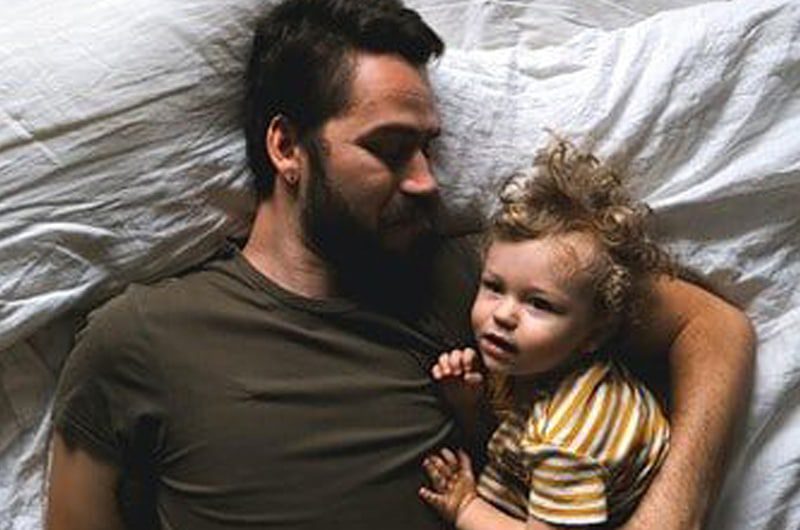I am ready to stop bed-sharing with my child. Where do I start?
If you’re co-sleeping, but don’t want to be: there is an end in sight!
Maybe co-sleeping was never your plan and it just sort of happened. Or maybe co-sleeping with a nursing infant made sense, but now you’d rather not share your bed with a sweaty, kicking toddler.
No matter the reason you’re ready to move your baby, or older child, out of your bed: it’s never too late. Change is always possible!
Seven step guide to move your toddler (or older child) out of your bed:
1. Check in with your partner
Make sure you are on the same page about what you need to get a good night’s sleep. Sleep arrangements can create a lot of stress in the family if parents do not agree on the solution. One parent might feel okay sharing the bed, while the other might feel crowded and can’t fall asleep.
2. Have a family meeting
For children ages three and older, it’s important to gather as a family and talk about what is not working well around sleep. Good communication is a key component of a successful transition (whatever are the habits you would like to change).
Don’t make the meeting about your child, instead talk about what the family can do to improve sleep. Share why sleep is important and tell your child why their sleep routine needs to change. Keep a positive tone – these changes are to get everyone to a better place.
Frequently Asked Question: “How do I tell my child in way that doesn’t bring tears?”
Answer: Tears may be inevitable but be positive and firm: “We would like to change the way we are sleeping. We all need to feel comfortable while we sleep and if we are all in the same bed it can be hard. Tonight, you get to start sleeping in your own room!” “After you get in bed, I will come check on you every five minutes.”
Frequently Asked Question: Your child might say “Why do you and dad/mom get to sleep together but I don’t?”
Answer: This is a valid question from your child. A good answer is that adults and young children have different schedules and children need more sleep. You can say “we want to make sure you get enough sleep, and we go to sleep a little later than you do”. It’s also ok to be honest with your child about your own selfcare needs. “Once you go to sleep, I like to be alone and in silence before going to sleep”. Or “Once you are asleep, dad and I like to chat and share some quiet time before going to bed.”
3. Setting the new routine
Decide where the new sleep routine will take place and the order of events. This might look like: brush teeth, read a book in your child’s room, snuggle in the child’s bed, lights out. Talk to your child what the new routine will look like. For older toddlers, you could even write it down for them like a checklist.
4. Role playing
For young children, representing the new routine with their own toys can help them understand the process better and communicate feelings. Is the bear sad when he says good night? What is mommy doing when she is not in the room?
5. Consistency.
Stay consistent all through the night, no exceptions! Once you start implementing the changes you agreed as a family, it’s important to follow through. For children it is difficult to understand exceptions. Why is it ok to go to your bed at 3am but not at bedtime?
Frequently Asked Question: “My child comes into my bed in the middle of the night and i don’t even notice. How do I change this?”
Answer: Until your child is able to stay in their own bed at night, make sure to wake up and walk them back to their room (or show them a mattress next to your bed), every time they come to your bed. Try putting a bell on your door that makes noise when your child opens it to help wake you up.
6. Welcome the feelings
I am a big advocate of this. Change is hard and can make your child angry, sad, worried and frustrated. Accept that your child might feel like this. It’s ok if they still want to sleep in your bed, you cannot change that feeling. But still, you can keep the new boundary and stay consistent to help your child adjust to the new routine.
And don’t forget to mourn the feelings of loss that might come with watching your child grow up… and don’t think of this as the end of snuggles with your child! You can cuddle with your child any time you want
7. Healthy bedtimes
No matter where and how your child sleeps, following an age-appropriate schedule is essential for good sleep. It’s important to be mindful of children’s natural need for sleep; any bedtime after 9 p.m. is too late.
Safe sleep recommendations. Is safe co-sleeping possible?
Setting aside parental philosophies, cultural practices and traditions, bed-sharing is the single greatest risk factor for sleep-related infant deaths between 0 and 12 months old. Some sleep experts define guidance on “safe co-sleeping”, while others say safe co-sleeping can’t be done.
If you have a young baby and you would like to co-sleep, consider using a bedside crib that will give your baby a safe space next to you during the night.
Check out our Safe Sleep Guide for more information on creating a safe sleep space for your baby.
Would you like to keep reading about co-sleeping/bed-sharing with your little ones? Check out more information here.
Good sleep is essential for a happy healthy childhood and life. Book a consultation with us now!
Subscribe to our Newsletter and get the latest in sales, sleep information and more









